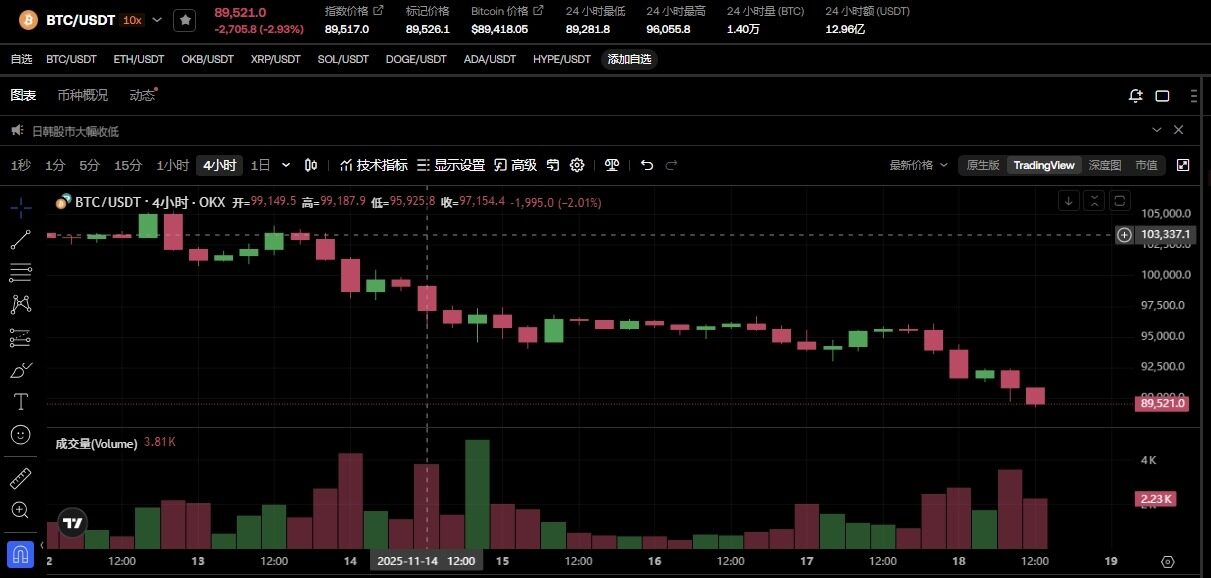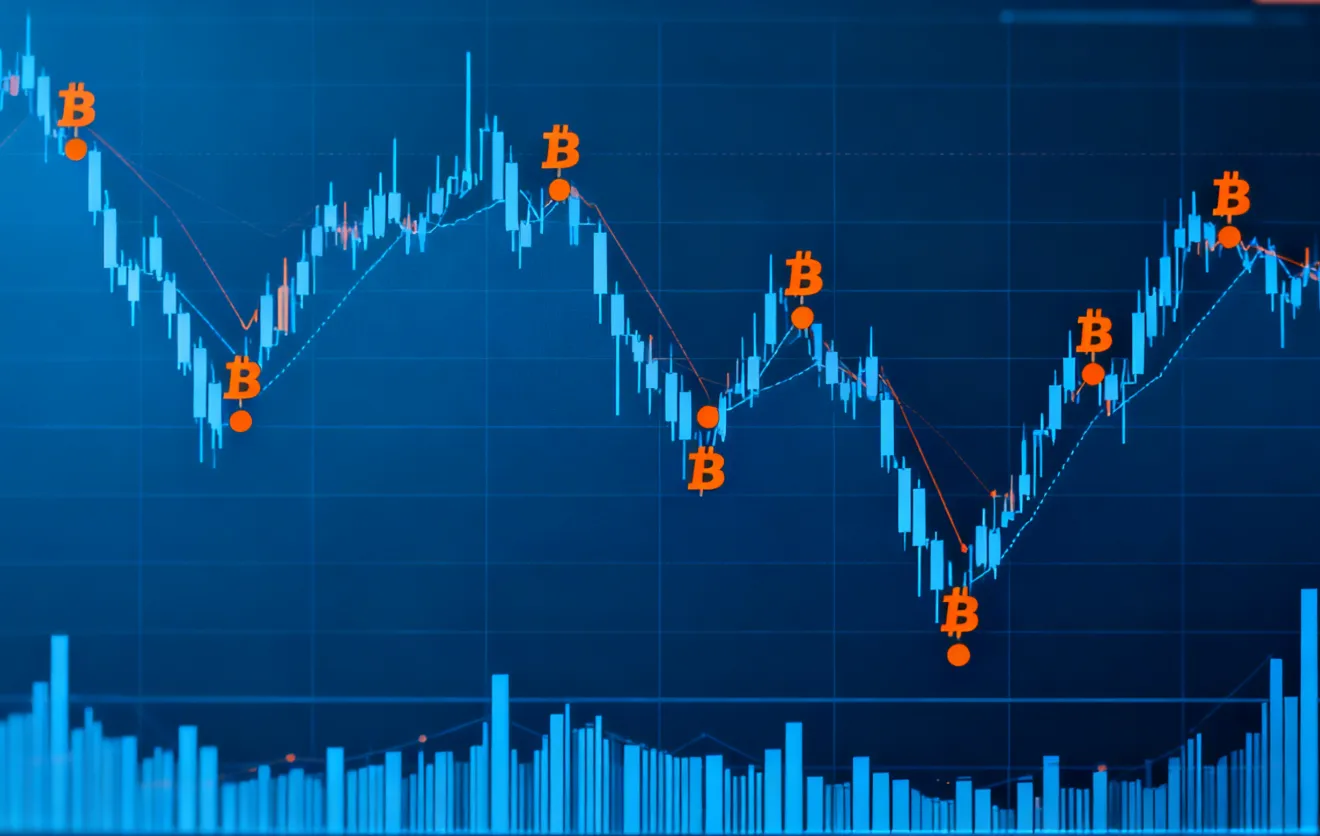Yesterday, the cryptocurrency market remained challenging, with market sentiment continuing to shift towards caution.
The declines in Bitcoin (BTC) and Ethereum (ETH) have both widened, reflecting that buyers are still hesitant and selling pressure is dominant. Unlike previous crashes, this decline resembles a steady and controlled pullback. This indicates that leverage is quietly decreasing rather than being aggressively liquidated.
Recent price movements of Bitcoin highlight this pattern. Earlier this week, Bitcoin made several attempts to return to higher levels but failed each time, leading to further weakening of momentum. As of the time of writing, Bitcoin is trading in the range of $89,500 to $89,600, down again from last week's levels. Ethereum's movements closely mirror those of Bitcoin, failing to break free from Bitcoin's constraints and unable to find effective support.
The overall tone of the market has shifted: declines are no longer seen as buying opportunities but have instead triggered silence and caution—indicating weak market confidence.
Past 24 Hours: Data Confirms Market Weakness
In the past 24 hours, Bitcoin's price has continued to decline.
From the 4-hour chart, the structure shows persistent downward pressure accompanied by increasing selling volume. Several brief attempts at rebounds quickly faded, indicating a lack of confidence among buyers. Larger sell orders and rising trading volume suggest that this trend may not be driven solely by retail sentiment.
Since November 14, Bitcoin has exhibited a clear trend pattern: lower highs, weakening rebound strength, and gradually increasing supply. If this trend continues, traders may shift their focus to deeper structural support areas rather than expecting a quick price rebound.
The decline has not triggered panic, but it has indeed brought about weakness. This alone is enough to make investors who anticipated a stronger rebound by the end of the year feel uneasy.

What Market Leaders Are Saying
Some notable figures have commented on the current market situation, providing context beyond the charts.
Tom Lee from Fundstrat attributes the current weakness to the aftermath of the deleveraging event on October 10. He believes that market makers' balance sheets may still be impaired, leading to a temporary liquidity shortage similar to quantitative tightening in the cryptocurrency space. However, Lee maintains that the current cycle has not yet reached its final peak, noting that the true top may still be one to three years away.

Arthur Hayes takes a more cautious view. He points out that Bitcoin's decline while the stock market remains high may signal that credit pressure is brewing. His liquidity model shows a weakening dollar. If policymakers intervene before liquidity tightens further, Bitcoin's price could drop to above $80,000. However, Hayes believes that once liquidity recovers, Bitcoin is still likely to see a strong long-term upward trend.
Cathie Wood remains optimistic about Bitcoin as an asset class. Although she acknowledges competition within the ecosystem—especially from stablecoins—she still views Bitcoin as a long-term macro asset rather than a speculative cyclical product.
These combined viewpoints suggest that the weakness may be structural rather than emotional—driven by liquidity mechanisms rather than weakened confidence.
The Federal Reserve's December Decision Significantly Impacts Market Sentiment
The uncertainty surrounding the Federal Reserve's upcoming decision has become another pressure point.
The probability of no interest rate cuts in December has risen significantly, becoming a common expectation in traditional markets and forecasting platforms. Despite recent political turmoil, traders seem more focused on data and central bank communications.
This shift is significant for asset classes closely related to liquidity conditions. Prolonged high interest rates will suppress speculative appetite, reduce leverage, and accelerate risk-averse behavior—all of which are now evident in the digital asset market.

Is This the Market Bottom?
It seems premature to assert that the market has bottomed out. The current market environment lacks the typical characteristics of a cycle's end: forced liquidations, capitulation selling, extreme panic, or severe valuation dislocation. Instead, the market appears to be slowly declining, seeking stability amid ongoing liquidity contraction.
But this does not mean that long-term investment strategies have become ineffective. Rather, it means that timing is crucial—rushing in based on assumptions rather than signals increases risk.
Looking Ahead
For now, it may be more appropriate to proceed with caution rather than aggressively building positions. Gradually accumulating positions, maintaining flexibility, and avoiding leverage may be wiser in the coming weeks.
The next round of expansion will eventually come—but the market may need to undergo a winter cycle to regain momentum. Until then, patience is not a sign of weakness.
This is discipline.
免责声明:本文章仅代表作者个人观点,不代表本平台的立场和观点。本文章仅供信息分享,不构成对任何人的任何投资建议。用户与作者之间的任何争议,与本平台无关。如网页中刊载的文章或图片涉及侵权,请提供相关的权利证明和身份证明发送邮件到support@aicoin.com,本平台相关工作人员将会进行核查。




